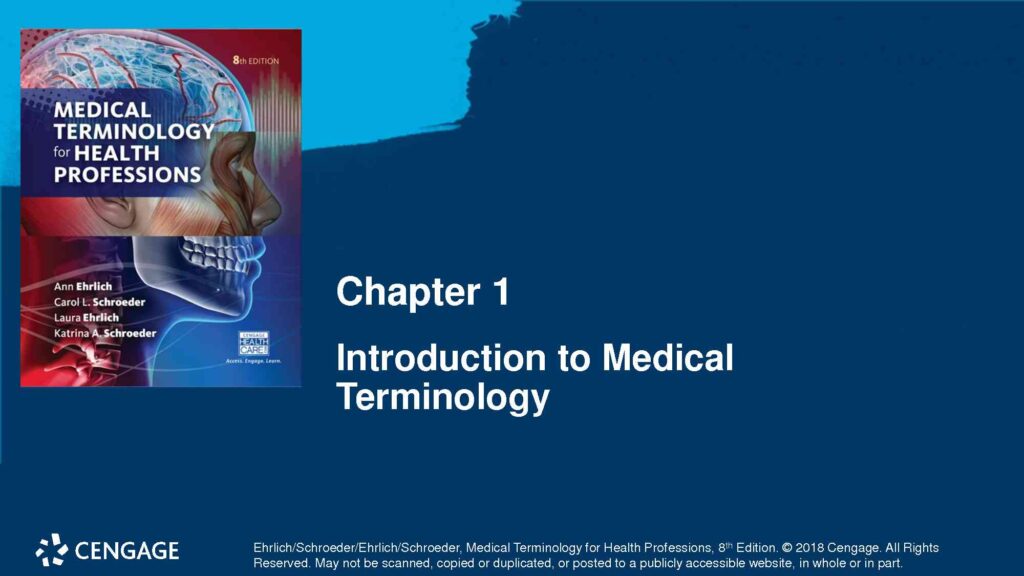Medical terminology is a crucial aspect of healthcare education, providing the foundation for understanding and communicating complex medical concepts. The “Medical Terminology for Health Professions, 8th Edition” is a widely used textbook for students pursuing careers in healthcare.
This guide will explore the benefits of purchasing a used version of this textbook, its relevance to health professions, and insights into its content and structure.
Why Choose a Used Textbook?
1. Cost-Effective Learning:
Buying used textbooks, such as the “Medical Terminology for Health Professions, 8th Edition,” can significantly reduce costs for students. New editions are often expensive, and purchasing a secondhand version allows students to save money while still accessing the same valuable educational content.
2. Environmentally Friendly:
Reusing textbooks is an environmentally conscious choice. By purchasing used books, you’re reducing the demand for new printed materials, which in turn helps lower the consumption of paper and other resources.
3. Same Content, Lower Price:
The content in used textbooks remains the same, ensuring that students still receive all the information they need to succeed in their courses. The “Medical Terminology for Health Professions, 8th Edition” covers essential medical terms, definitions, and examples crucial for healthcare studies.
Overview of Medical Terminology for Health Professions, 8th Edition:

1. Comprehensive Introduction to Medical Terminology:
This textbook offers an in-depth introduction to the language of healthcare, equipping students with the skills to understand, pronounce, and utilize medical terms. It systematically breaks down complex terminology, making it accessible even for beginners.
2. Relevance to Health Professions:
Medical terminology is the universal language of healthcare professionals. Nurses, physicians, medical coders, and other healthcare workers rely on this language to communicate effectively. The 8th edition provides specific examples and case studies that reflect real-world applications of these terms in various health professions.
3. Structured Learning:
The textbook’s structure is designed for easy navigation and gradual learning. Chapters are organized to introduce basic concepts before advancing to more complex medical terms, ensuring that students build a solid foundation in their understanding of medical language.
Key Features of the 8th Edition:
1. Updated Terminology:
The “Medical Terminology for Health Professions, 8th Edition” includes the latest medical terms and definitions, keeping students up-to-date with current healthcare practices and language.
2. Interactive Learning Tools:
This edition offers supplementary learning tools such as flashcards, quizzes, and exercises to reinforce understanding and retention of medical terminology. These tools are essential for mastering complex medical language and improving memory recall.
3. Pronunciation Guides:
Medical terms can be challenging to pronounce, especially for new learners. The textbook provides detailed pronunciation guides to help students articulate terms correctly, which is a critical skill for healthcare professionals who communicate with patients and colleagues.
4. Visual Aids and Diagrams:
The 8th edition is rich in illustrations and diagrams that help students visualize medical concepts, body systems, and anatomical terms. Visual aids are particularly helpful for understanding difficult terms related to human anatomy and physiology.
Buying Guide for Used Textbooks:
1. Where to Buy Used Copies?
There are numerous platforms where students can find used copies of the “Medical Terminology for Health Professions, 8th Edition.” Websites like Amazon, eBay, and specialized textbook resellers often offer secondhand editions at reduced prices.
2. Condition Matters:
When buying a used textbook, always check the condition of the book. Look for copies with minimal wear and tear, no missing pages, and intact binding. Many sellers provide detailed descriptions and images of the book’s condition, so it’s important to review them before making a purchase.
3. Digital vs. Physical Used Textbooks:
Digital textbooks have gained popularity in recent years, offering a convenient and portable way to study. However, physical textbooks still have advantages, such as the ability to annotate, highlight, and quickly flip through pages. Students should weigh the pros and cons of digital versus physical used books based on their study habits and preferences.
Advantages of Using the 8th Edition in Medical Studies:
1. Alignment with Course Curriculum:
The “Medical Terminology for Health Professions, 8th Edition” is often aligned with the curriculum of many healthcare programs. Whether you’re studying nursing, medical billing, or any other healthcare profession, this textbook provides the necessary foundation for mastering medical terminology.
2. Ease of Understanding:
The textbook is designed with students in mind, offering clear explanations, examples, and exercises to make learning medical terms easier. The user-friendly layout ensures that students can absorb information effectively, making it ideal for both self-study and classroom use.
3. Practical Application:
In addition to providing definitions, the textbook emphasizes the practical application of medical terminology in real-world settings. Students learn how to use these terms in medical charts, reports, and patient interactions, bridging the gap between theoretical knowledge and practical use.
How Medical Terminology Shapes Your Healthcare Career?
1. Communication with Colleagues:
Healthcare professionals must communicate clearly and precisely with one another. Understanding medical terminology is vital for conveying diagnoses, treatment plans, and patient history accurately. This ensures that all members of a healthcare team are on the same page, improving patient outcomes.
2. Documentation and Record-Keeping:
Accurate medical documentation is critical in healthcare. The terms learned from this textbook will be used regularly in medical records, insurance forms, and patient care plans. Mastery of medical terminology helps prevent misunderstandings and errors in patient care.
3. Improving Patient Interactions:
While healthcare professionals use complex terms with each other, they must also explain these terms to patients in simple language. Understanding medical terminology allows professionals to break down complex concepts for patients, improving communication and patient trust.
Study Tips for Medical Terminology:

1. Regular Practice:
To retain medical terminology, regular practice is essential. Create flashcards, engage with the textbook’s quizzes, and test yourself frequently to build and maintain your vocabulary.
2. Engage with Multimedia Resources:
Beyond the textbook, students can use videos, podcasts, and apps to reinforce their understanding of medical terminology. Engaging with different types of media helps diversify learning and improves long-term retention.
3. Group Study:
Studying medical terminology with a group can be beneficial. Group discussions, quizzes, and explanations from peers can enhance understanding and make studying more interactive.
FAQ’s:
1. What makes the 8th edition of this textbook different from previous versions?
The 8th edition includes updated medical terminology, improved learning tools, and additional case studies, ensuring students are learning the most current language used in healthcare.
2. Can I still benefit from a used version of this textbook?
Yes, used versions provide the same educational content at a lower price, making them a cost-effective choice for students.
3. Is the content of the 8th edition relevant for all health professions?
Yes, the textbook is designed for a broad range of health professions, including nursing, medical coding, and healthcare administration.
4. Are the interactive learning tools available in used copies?
Some used textbooks may still include access to online resources, but it’s important to check the seller’s description for details about supplemental material.
5. What is the best way to study medical terminology?
Regular practice, using flashcards, engaging with quizzes, and studying in groups are all effective ways to master medical terminology.
6. How does this textbook help with real-world healthcare scenarios?
The textbook includes practical examples, case studies, and exercises that reflect real-world medical settings, helping students apply terminology in a professional context.
7. Where can I find used copies of this textbook?
Websites like Amazon, eBay, and specialized textbook resellers often offer used copies at discounted prices.
8. Is it better to buy a physical or digital used textbook?
This depends on personal preference. Physical textbooks allow for easy annotation, while digital versions are portable and often more accessible on the go.
9. Does the 8th edition include pronunciation guides?
Yes, detailed pronunciation guides are provided for all medical terms, helping students learn how to articulate terms accurately.
Closing Remarks:
The “Medical Terminology for Health Professions, 8th Edition” remains an invaluable resource for anyone pursuing a career in healthcare. From its cost-effectiveness as a used textbook to its comprehensive content, this edition equips students with the knowledge they need to excel in the medical field.